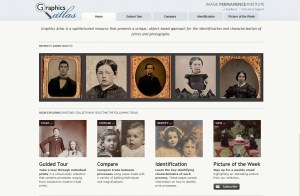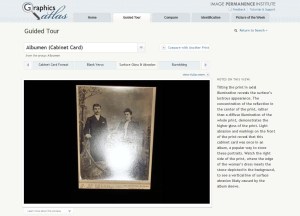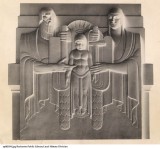Undated photographs are the bane of any family researcher’s existence. While there are various methods for dating photographs—examining the style of clothing, for example, or looking for contextual clues in the background such as modes of transportation, architecture, and signage—determining which photographic process was used can help narrow down the time period in which it was taken.
Enter Graphics Atlas, a Web site created by the Image Permanence Institute at R.I.T. Graphics Atlas offers a unique approach to dating prints and photographs by identifying the processes used to create them. And while it may seem intimidating at first, the site features step-by-step tutorials to help you do the detective work involved in ascertaining a photo’s process and approximate date.
Graphics Atlas features a multi-faceted point of entry in which users can drill down from a broad overview of the various photographic processes, compare two processes side-by-side, and finally zero in on the one that matches the photo they are trying to date.

Image taken from http://www.graphicsatlas.org, Image Permanence Institute.
For a visual synopsis of photographic processes through the centuries, a good place to start is the Timeline, which can be found in the Guided Tour section of the site. Clicking on any of the processes will open a pop-up listing the different types of photographs within that process, along with the date range of their use.

Image taken from http://www.graphicsatlas.org, Image Permanence Institute.
Let’s try to identify the process used in the following photograph.
This is a cabinet card of Frank Worcester Elwood, a Rochester attorney for whom the now-razed Elwood Building at State and Main streets was named. Elwood was born in 1850. In the photo, he looks to be roughly 30 years old, which would put the date of the photo circa 1880. To confirm that date, looking at the timeline on Graphics Atlas, the most likely processes used in this photograph would have been albumen, carbon, or platinum.
The emulsion of the photograph has suffered very little deterioration and retains its rich tonality. While these traits are characteristic of platinum prints, Graphics Atlas tells me that most platinum prints have a matte surface, while the surface of the Elwood photograph is a semi-gloss. In addition, platinum was just starting to achieve common use in 1880, so it’s more likely that the process used was an earlier, more established one such as albumen, in use from roughly 1855 to 1920. Or carbon, which had its heyday from 1860 to 1940. Let’s have a look at both.

Image taken from http://www.graphicsatlas.org, Image Permanence Institute.
One of the key identifying features of any photographic process is how visible the paper fibers are, something best determined under magnification. However, since I don’t have a powerful enough magnifying glass, paper fibers aren’t really a big help here. I know from experience that albumen prints are prone to fading, cracking, and yellowing over time, but none of that is evident in the Elwood picture. In Care and Identification of 19th-Century Photographic Prints, a sort of companion book to the Web site, author and IPI founder James M. Reilly states that “the image color of 19th-century carbon prints…will often be quite close to that of a well-preserved albumen print” (p. 64). So, it’s possible that the Elwood photo is an example of an albumen print that was lucky enough to be stored properly.
Let’s break it down.
Using the light source function of the Compare tool, I determined that the surface gloss of a carbon print is pretty close to that of the Elwood photo. Yet another convincing factor is the image stability of carbon prints, which the Elwood photo also exhibits. In contrast, albumen isn’t particularly known for its ability to resist fading. In fact, the other photos found with the Elwood print—kept in the exact same storage conditions—appear to be deteriorated albumen prints, as evidenced in the photo below.
So, there’s a case to be made for carbon.
But the lack of image relief in the Elwood print is indicative of albumen rather than carbon. Also, the surface gloss of the sample albumen print in Graphics Atlas is similar to that of the Elwood print. Finally, the Elwood print exhibits the rich, purple-brown tones characteristic of albumen.

Image taken from http://www.graphicsatlas.org, Image Permanence Institute.
So, it could also be albumen. Whether albumen or carbon, I can be fairly certain that my initial date estimate of 1880 was correct as both processes were in popular use during that time period.
My not-so-educated guess? I think it’s an extraordinarily well-preserved albumen print. Once I got past my initial “albumen-is-always-faded-and-yellow” attitude, the lack of image relief, the glossiness of the surface, and the purple-brown tones especially, convinced me. Am I right? I have no idea. On December 8, guest speaker Alice Carver-Kubik, IPI research scientist and one of the key developers of Graphics Atlas, will lead a discussion on identifying and dating photographs at the Local History & Genealogy Division’s weekly Family Detectives Club series. I plan on bringing Mr. Elwood to the party.
~Cheri Crist
Librarian
Sources
Reilly, James M. Care and Identification of 19th-Century Photographic Prints. (Rochester: Eastman Kodak Co., 2009).



